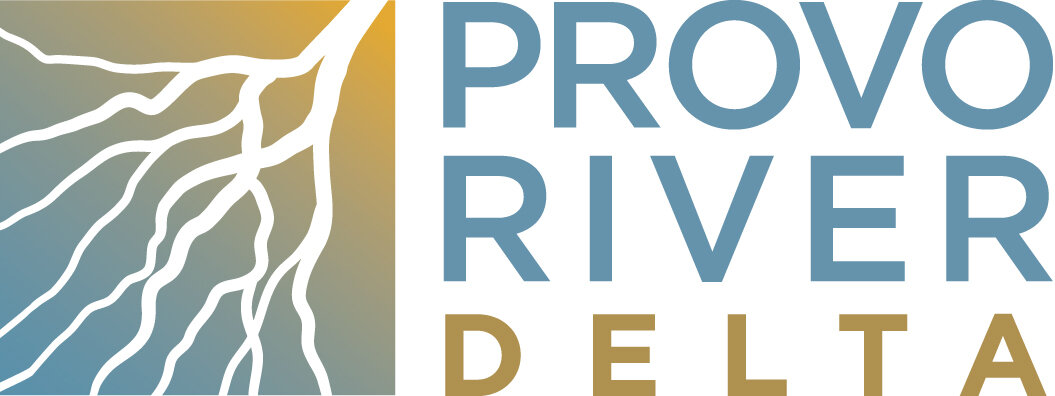Frequently Asked Questions
Also see our About the Project page for project description and timeline.
What is the delta restoration project’s purpose? The purpose of the Provo River Delta Restoration Project is to help recover the threatened June sucker, and in doing so, restore the area’s natural ecosystem. Prior to the project, the last 1.5 miles of Provo River did not support a healthy ecosystem as it had historically. June sucker were particularly impacted by its deep, channelized (artificially restricted by dikes) nature and limited June suckers’ ability to reproduce, grow and survive. The project also provides additional recreational experiences in and around the original lower Provo River and the newly restored delta. By building this project, partners in the June Sucker Recovery Implementation Program help ensure important water projects linked to June sucker recovery stay on track. The diversity of habitats and function supported by the delta area will provide the necessary conditions for juvenile June sucker to develop to a size where they can survive in Utah Lake.
What about area recreation? Recreational development that is compatible with the project’s purpose was an integral element of the project. This included construction of new paved trail and trailhead, wildlife observation tower, parking and non-motorized boat ramps.
How does the project address mosquitos? The extent to which the project would increase mosquito habitat was analyzed and described in the project's Environmental Impact Statement. The Project provides funding to Utah County to conduct additional monitoring in the project vicinity. This information is used to guide mosquito control efforts.
Why save the June sucker? The June sucker is an indicator species and the fact it is struggling indicates a larger problem with the Utah Lake ecosystem. By helping June sucker, we help the ecosystem in which it lives, which has benefits for fish and people alike. The livelihood of the June sucker is also tied to area water development. Past water development in Wasatch and Utah Counties contributed to the endangerment of June sucker; the Endangered Species Act required we take measures to recover June sucker to ensure continued development and operation of water projects to meet current and future water needs.
How has the original lowest portion of Provo River been affected? The downstream-most section of the original Provo River channel, now named the Old Provo Channel, remains and receives a guaranteed minimum flow of water through a contructed diversion structure. A small dam at the end of the channel, near Utah Lake, was constructed to maintain a relatively constant water level year-round, and an aeration system has been installed to maintain oxygen levels that support a community fishery. Other improvements along the channel include non-motorized boat launches and fishing piers.
Is hunting allowed? Utah Division of Wildlife Resources (UDWR) will own and manage the delta, partially as a Waterfowl Management Area which is now open to fishing and waterfowl hunting, but hunters should note there are several no-shooting zones in the area. The No Shooting Area (safety zone) exists to ensure the safety of all those in the delta, nearby Provo High School, and adjacent private properties. Respecting the safety zone and private property boundaries will help ensure the future of hunting on the Provo River Delta. Visitors should note they will find many large, easy-to-spot signs that identify the hunt area boundaries within the delta, as well as multiple maps and signs along the trails to serve as a reminder that hunting is allowed only in specific areas. Anglers and boaters should be area of area fishing regulations and that only nonmotorized boats will be allowed in the delta.
How was the land acquired for this project? Landowners within the desired project footprint were approached with offers to purchase their land; purchase agreements were reached on all required parcels. The project footprint was reduced to balance project needs with land that could be acquired on a willing-seller basis.
What is the construction timeline? Construction activities began in March 2020 and were mostly completed in the delta in 2024. Recreation features in the Old Provo Channel and the Delta Gateway Park construction continued in 2025. Monitoring of the project will continue beyond project completion.
What is the project cost? The delta project is a feature of the Central Utah Project (CUP) and was estimated to cost approximately $51 million when construction began. This amount represents about 1.7% of the cost of building the CUP.
Project funds include annual Congressional appropriations and interest from a mitigation account created with contributions from the State of Utah, Western Area Power Administration, Central Utah Water Conservancy District, and federal appropriations.
About 50% of total PRDRP costs are for land and construction of the restored delta. About 20% of the costs are for recreation features and improvements to the existing river channel, and the remaining 30% covers modifications to road projects and utility lines to accommodate the delta project.
The Provo River Delta Restoration Project (PRDRP) and progress toward June sucker recovery are required components of the Diamond Fork and Utah Lake Systems of the Central Utah Project (CUP).
The CUP is a federally-funded series of reservoirs, tunnels, and pipelines that supply 1.2 million Utah residents along the Wasatch Front and Central Utah with water for drinking, irrigation, and industrial uses.
Authority for the CUP and the PRDRP came from the Central Utah Project Completion Act of 1992.


